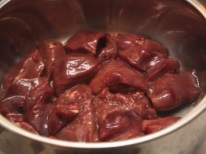At what age can you give a child a liver?
Many adults love liver dishes, so in their families such a product is in demand and appears on the table quite often. And when a baby grows up in the family, ready to try complementary foods, parents are interested in whether it can be entered into the children's menu in the first year of life. At the same time, there are questions about when to give beef liver, and when you can introduce chicken or pork. In search of answers, it is worth finding out whether there is a benefit for the child’s body from using it, whether this product is harmful to children, and how to prepare it for children correctly.
What is useful
- It is a protein dish from which children get the entire list of amino acids necessary for their bodies. Among them are all the essential amino acids that are not formed in the body, but get into it with food.
- Dishes from it will give the child many vitamins, among which are especially many vitamins E, A and D (fat soluble), folic acid, choline and other B vitamins. The liver also acts as a source of various mineral salts, such as iron, copper, calcium, selenium, magnesium and many others.
- The cholesterol contained in it is important for the synthesis of hormones and other compounds, so a small amount must be ingested into a child’s body.
- The use of the liver can prevent the development of anemia and hypovitaminosis, and also has a positive effect on the immunity of the child and the growth processes in his body.
Minuses
- In some children, it provokes an allergic reaction.
- Due to the high protein content, meals from it are not recommended for children with kidney disease.
- Excessive consumption worsens the work of the digestive tract.
- Due to the presence of a small bitterness in the taste of the liver, some children refuse such a product.
How many months can I give?
It is possible to acquaint the child with such type of an offal as a liver about one year. It is advisable to start an introduction to the supplement after the child has tried meat dishes and is used to them. Most children can offer it for the first time from 8-9 months. At first, the product is simply boiled and frayed carefully until a homogeneous and not too thick consistency is obtained.
To the one-year-old child, souffles, pates, casseroles, soups, puddings and other dishes are prepared from the liver. When a baby learns to chew well, it can be treated with stewed and oven-baked liver, and fried dishes from such a product, for example, liver pancakes, do not give before 3 years of age. As for the question of what to give the liver, then often this product is combined with vegetable dishes. It can be supplemented and cereal side dish.
Which is better to choose for baby food?
There are several types of liver and each has its own advantages for inclusion in the children's diet.
Baby can be offered such a liver:
- Beef or calf. Since it is advised to start feeding the liver, because such a product is absorbed very easily and rarely causes allergies. Beef liver has a high content of vitamin A and B vitamins, as well as low calorie content. Its use maintains hemoglobin at a high level and increases the body's defenses. The downside is some harshness and the need to spend time cleaning from the bile ducts and films.
- Chicken. Its advantages include the tenderness of texture and pleasant taste. In addition, it is prepared for cooking and cooks faster than other types of by-products. This product is rich in iron and folic acid, therefore it has a positive effect on immune function and blood formation. It also contains a lot of choline, which has a beneficial effect on the nervous system and brain activity of the child.
- Pig. This type of liver consistency is quite tender and loose, and the calorie content of the product is low. In addition, it prepares rather quickly, but it does not have any hard films. However, this by-product has drawbacks, among which a somewhat reduced content of useful substances, as well as the frequent presence of a bitter taste in ready-made dishes. However, children get iron, copper, manganese, vitamins A, E, B groups, cobalt, iodine and many other substances from pork liver.
- Turkey Like chicken, turkey liver is easily digested, quickly boiled, has a delicate structure and a pleasant taste. At the same time, it is quite high in calories due to its high fat content (it has almost twice as many calories as beef, pork or chicken). From her child will receive vitamins B12, K and C, selenium, iron, phosphorus, chromium, vitamin PP and many other valuable compounds.
- A rabbit. This product contains many vitamins and minerals, including beta-carotene, calcium, tin, selenium, vitamin D, cobalt, vitamin K, choline and others. The only downside to this delicious look is the high cost. In addition, it is found in the sale of much less chicken, pork or beef liver.
- Cod. This delicacy product is rich in vitamin A, zinc, iodine, vitamin D and calcium. Its use will help prevent rickets, diseases of the skin and teeth, as well as strengthen the bones and protect the baby from infections. Such a liver is also very useful for the state of the cardiovascular system.
Separately, we note that goose and duck liver should not be given to children, since such products are very high in calories and contain significant amounts of saturated fat.
How to enter into the diet
The first dish for the children's menu is a one-component mashed potatoes. It is given in the amount of not more than half a teaspoon. In this case, it is desirable to treat the crumb to the first portion in the morning, so that during the day you can note any adverse effects of the new product. If intolerance is not detected, the portion gradually increases. Liver offer 1-2 times a week, replacing the meat dish. By the year the baby can give it up to 60 g per day.
If the crumb has reacted to the liver with any allergy symptoms, the product is discarded. Also, wait with the introduction of liver mash is worth with the reluctance of the baby to try this dish. You should not force the crumb to eat it forcibly, so as not to provoke even greater rejection. It is better to postpone the tasting for several weeks, and then prepare the dish for the child again.
Ready mashed potatoes
Liver is found in the assortment of many manufacturers of baby food, for example, mashed beef with liver is offered under the brands “Babushkino Lukoshko”, “Frutonyanya” and “Tyoma”, and Semper produces mashed beef liver with vegetables for children over 8 months. When buying such jars, it is important to pay attention to the shelf life and composition of mashed potatoes, trying to choose a product with a minimum of additives.As a rule, the packaging of these products is small (80-100 g), since an open jar can be stored in a refrigerator for no longer than 24 hours.
How to make mashed potatoes
Making a liver mash at home with your own hands is quite simple. This requires only fresh liver, a little time and effort. Buy children only high-quality chilled product (do not take frozen), which has a smooth color, shiny surface, the smell is slightly sweet. Do not acquire a liver on which there is bloom or visible spots.
After washing the product under running water and removing films from it, it is recommended to soak the liver for half an hour in water or in milk. This will help get rid of the bitterness that is almost always present in her taste.
Next mash is prepared as follows:
- After cutting the liver into small pieces, the product is poured with cool water and allowed to boil.
- Cooking by-product lasts 15-30 minutes (time depends on the type of liver).
- Boiled liver is removed from the water and placed in a blender bowl.
- The product is crushed and rubbed twice through a sieve, adding if necessary (if the puree turns out to be too thick) a little water, breast milk or mixture.
Read more about the benefits and choices in the next program.





































































